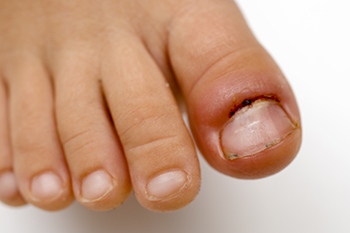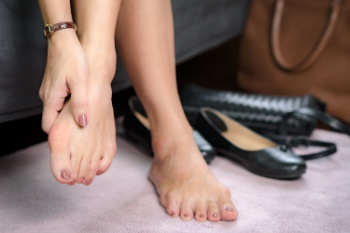Items filtered by date: February 2025
Plantar Warts Can Be Treated!
Signs and Causes of Toe Infections

A toe infection can cause pain, swelling, redness, and discharge, making daily activities difficult to complete. Common causes of toe infections include fungal infections like athlete’s foot or toenail fungus, bacterial infections from cuts or injuries, and ingrown toenails. Fungal infections thrive in warm, moist environments and can spread through shared surfaces or personal items. Bacterial infections often develop when bacteria enter the skin through small breaks, such as improperly trimmed nails or blisters. People with diabetes or circulation problems are at a higher risk, as they may not feel early symptoms, which allows infections to get worse. Signs of a more serious infection include fever, warmth surrounding the toe, or red streaks moving up the foot. Without treatment, an infection can spread to deeper tissues, increasing the risk of serious complications. A podiatrist can diagnose the cause of your infected toe, clean the affected area, and recommend the appropriate treatment. Antifungal medication, antibiotics, or minor procedures to remove infected tissue are among the options. If you believe your toe has become infected, it is suggested that you schedule an appointment with a podiatrist for an exam, diagnosis, and treatment.
Toe pain can disrupt your daily activities. If you have any concerns, contact Thomas Vail, DPM of Step Alive Foot & Ankle Center. Our doctor can provide the care you need to keep you pain-free and on your feet.
What Causes Toe Pain?
Most severe toe pain is caused due to a sports injury, trauma from dropping something heavy on the toe, or bumping into something rigid. Other problems can develop over time for various reasons.
Toe pain can be caused by one or more ailments. The most common include:
- Trauma
- Sports injury
- Wearing shoes that are too tight
- Arthritis
- Gout
- Corns and calluses
- Hammertoe
- Bunions
- Blisters
- Ingrown toenails
- Sprains
- Fractures (broken bones)
- Dislocations
When to See a Podiatrist
- Severe pain
- Persistent pain that lasts more than a week
- Signs of infection
- Continued swelling
- Pain that prevents walking
Diagnosis
In many cases the cause of toe pain is obvious, but in others, a podiatrist may want to use more advanced methods to determine the problem. These can range from simple visual inspections and sensation tests to X-rays and MRI scans. Prior medical history, family medical history, and any recent physical traumatic events will all be taken into consideration for a proper diagnosis.
Treatment
Treatments for toe pain and injuries vary and may include shoe inserts, padding, taping, medicines, injections, and in some cases, surgery. If you believe that you have broken a toe, please see a podiatrist as soon as possible.
If you have any questions please feel free to contact our office located in Findlay, OH . We offer the newest diagnostic tools and technology to treat your foot and ankle needs.
The Lasting Impact of Women’s Shoe Choices

Many women experience foot pain later in life, often due to years of wearing fashionable but unsupportive shoes. High heels, pointed toes, and narrow-fitting styles put excessive pressure on the forefoot, leading to bunions, hammertoes, and chronic joint pain. Decades of squeezing into restrictive footwear can also contribute to nerve damage, calluses, and structural changes in the feet. Men, on the other hand, are less likely to develop foot pain from past footwear choices. Their shoes tend to have a wider toe box, lower heels, and better arch support, reducing long-term strain. While men can still develop foot issues, their footwear history rarely plays as significant a role. If you are a female dealing with lingering foot pain, it is suggested that you see a podiatrist who can help correct or manage the damage caused by years of wearing impractical footwear.
Foot Pain
Foot pain can be extremely painful and debilitating. If you have a foot pain, consult with Thomas Vail, DPM from Step Alive Foot & Ankle Center. Our doctor will assess your condition and provide you with quality foot and ankle treatment.
Causes
Foot pain is a very broad condition that could be caused by one or more ailments. The most common include:
- Bunions
- Hammertoes
- Plantar Fasciitis
- Bone Spurs
- Corns
- Tarsal Tunnel Syndrome
- Ingrown Toenails
- Arthritis (such as Gout, Rheumatoid, and Osteoarthritis)
- Flat Feet
- Injury (from stress fractures, broken toe, foot, ankle, Achilles tendon ruptures, and sprains)
- And more
Diagnosis
To figure out the cause of foot pain, podiatrists utilize several different methods. This can range from simple visual inspections and sensation tests to X-rays and MRI scans. Prior medical history, family medical history, and any recent physical traumatic events will all be taken into consideration for a proper diagnosis.
Treatment
Treatment depends upon the cause of the foot pain. Whether it is resting, staying off the foot, or having surgery; podiatrists have a number of treatment options available for foot pain.
If you have any questions, please feel free to contact our office located in Findlay, OH . We offer the newest diagnostic and treatment technologies for all your foot care needs.
Bunions Worsen With Age and Are More Common in Women

Bunions tend to worsen over time and are more prevalent in women due to a combination of genetic, structural, and footwear-related factors. Aging weakens connective tissues, leading to joint instability and increased toe misalignment. Women are particularly at risk because of shoes with narrow toe boxes and high heels, which place excessive pressure on the forefoot and push the big toe out of alignment. Hormonal changes may also contribute by affecting ligament flexibility. As bunions progress, they can cause pain, swelling, and difficulty walking. Choosing supportive, wide-toe shoes and avoiding prolonged use of restrictive footwear can help slow progression. Strengthening foot muscles with targeted exercises may also provide relief. For persistent discomfort or severe deformity, it is suggested that you see a podiatrist who can offer personalized solutions, including orthotics, padding, or surgical options to improve comfort and function as the condition advances.
If you are suffering from bunion pain, contact Thomas Vail, DPM of Step Alive Foot & Ankle Center. Our doctor can provide the care you need to keep you pain-free and on your feet.
What Is a Bunion?
Bunions are painful bony bumps that usually develop on the inside of the foot at the joint of the big toe. As the deformity increases over time, it may become painful to walk and wear shoes. Women are more likely to exacerbate existing bunions since they often wear tight, narrow shoes that shift their toes together. Bunion pain can be relieved by wearing wider shoes with enough room for the toes.
Causes
- Genetics – some people inherit feet that are more prone to bunion development
- Inflammatory Conditions - rheumatoid arthritis and polio may cause bunion development
Symptoms
- Redness and inflammation
- Pain and tenderness
- Callus or corns on the bump
- Restricted motion in the big toe
In order to diagnose your bunion, your podiatrist may ask about your medical history, symptoms, and general health. Your doctor might also order an x-ray to take a closer look at your feet. Nonsurgical treatment options include orthotics, padding, icing, changes in footwear, and medication. If nonsurgical treatments don’t alleviate your bunion pain, surgery may be necessary.
If you have any questions, please feel free to contact our office located in Findlay, OH . We offer the newest diagnostic and treatment technologies for all your foot care needs.
Risk Factors for Ankle Sprains and Strains

Ankle sprains and strains are distinct injuries, though they are often confused due to their similar symptoms. A sprain involves damage to the ligaments, which are bands of tissue that connect bones in the ankle joint. Sprains typically occur when the foot twists or rolls awkwardly, stretching or tearing the ligaments. Common signs include swelling, bruising, and difficulty bearing weight. In contrast, a strain affects the muscles or tendons, which are the tissues connecting muscles to bones. Strains often result from overstretching or overuse, causing muscle pain, cramping, and limited motion in the ankle. Both injuries can destabilize the ankle, increasing the risk of further chronic instability or changes in gait. A podiatrist can determine the type and severity of the injury, recommend proper footwear or orthotics to provide support, and advise on strengthening exercises to restore stability. If you have injured your ankle, it is suggested that you schedule an appointment with a podiatrist for an exam and appropriate treatment.
Ankle pain can have many different causes and the pain may potentially be serious. If you have ankle pain, consult with Thomas Vail, DPM from Step Alive Foot & Ankle Center. Our doctor will assess your condition and provide you with quality foot and ankle treatment.
Ankle pain is any condition that causes pain in the ankle. Due to the fact that the ankle consists of tendons, muscles, bones, and ligaments, ankle pain can come from a number of different conditions.
Causes
The most common causes of ankle pain include:
- Types of arthritis (rheumatoid, osteoarthritis, and gout)
- Ankle sprains
- Broken ankles
- Achilles tendinitis
- Achilles tendon rupture
- Stress fractures
- Tarsal tunnel syndrome
- Plantar fasciitis
Symptoms
Symptoms of ankle injury vary based upon the condition. Pain may include general pain and discomfort, swelling, aching, redness, bruising, burning or stabbing sensations, and/or loss of sensation.
Diagnosis
Due to the wide variety of potential causes of ankle pain, podiatrists will utilize a number of different methods to properly diagnose ankle pain. This can include asking for personal and family medical histories and of any recent injuries. Further diagnosis may include sensation tests, a physical examination, and potentially x-rays or other imaging tests.
Treatment
Just as the range of causes varies widely, so do treatments. Some more common treatments are rest, ice packs, keeping pressure off the foot, orthotics and braces, medication for inflammation and pain, and surgery.
If you have any questions, please feel free to contact our office located in Findlay, OH . We offer the newest diagnostic and treatment technologies for all your foot care needs.

